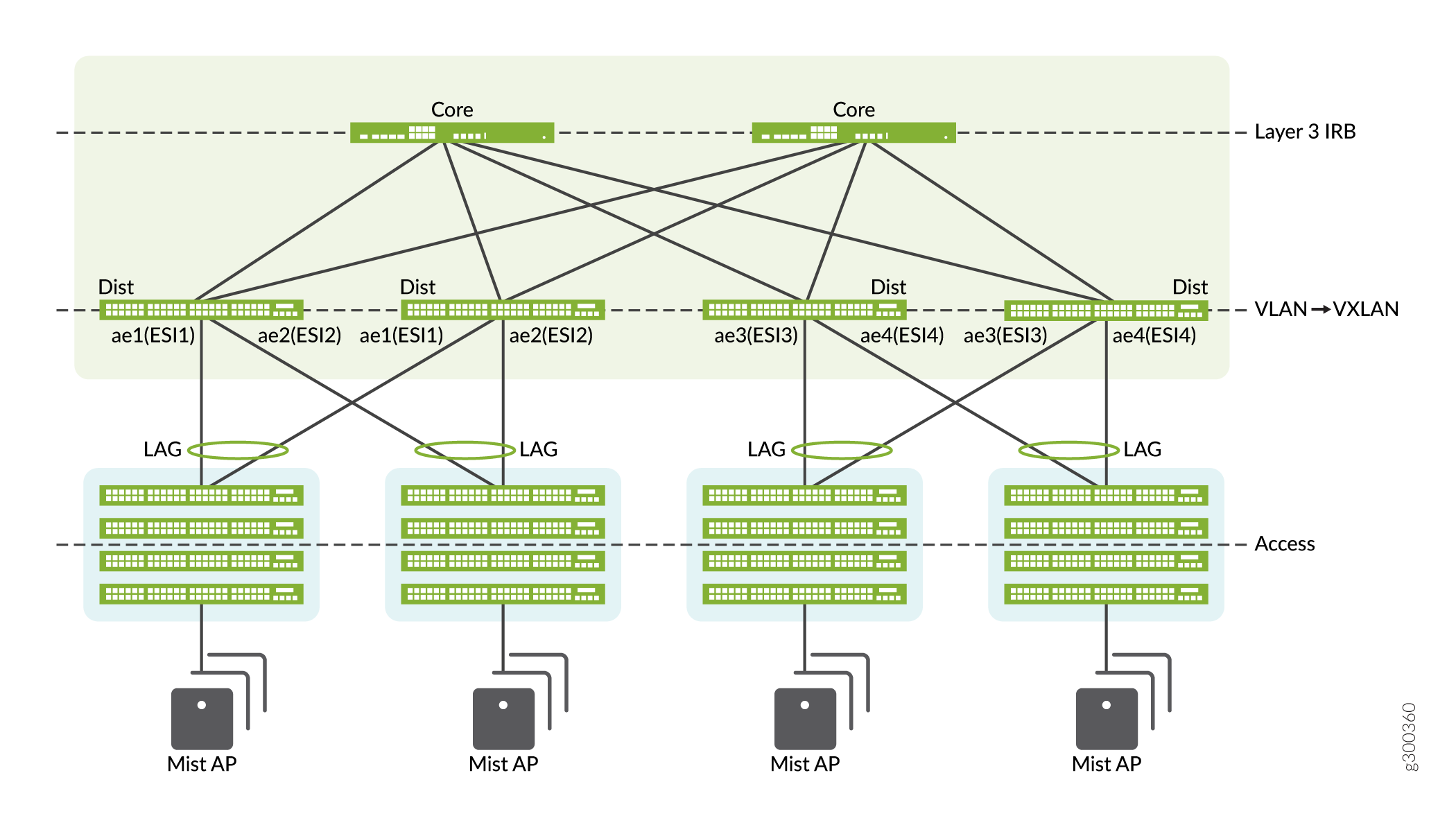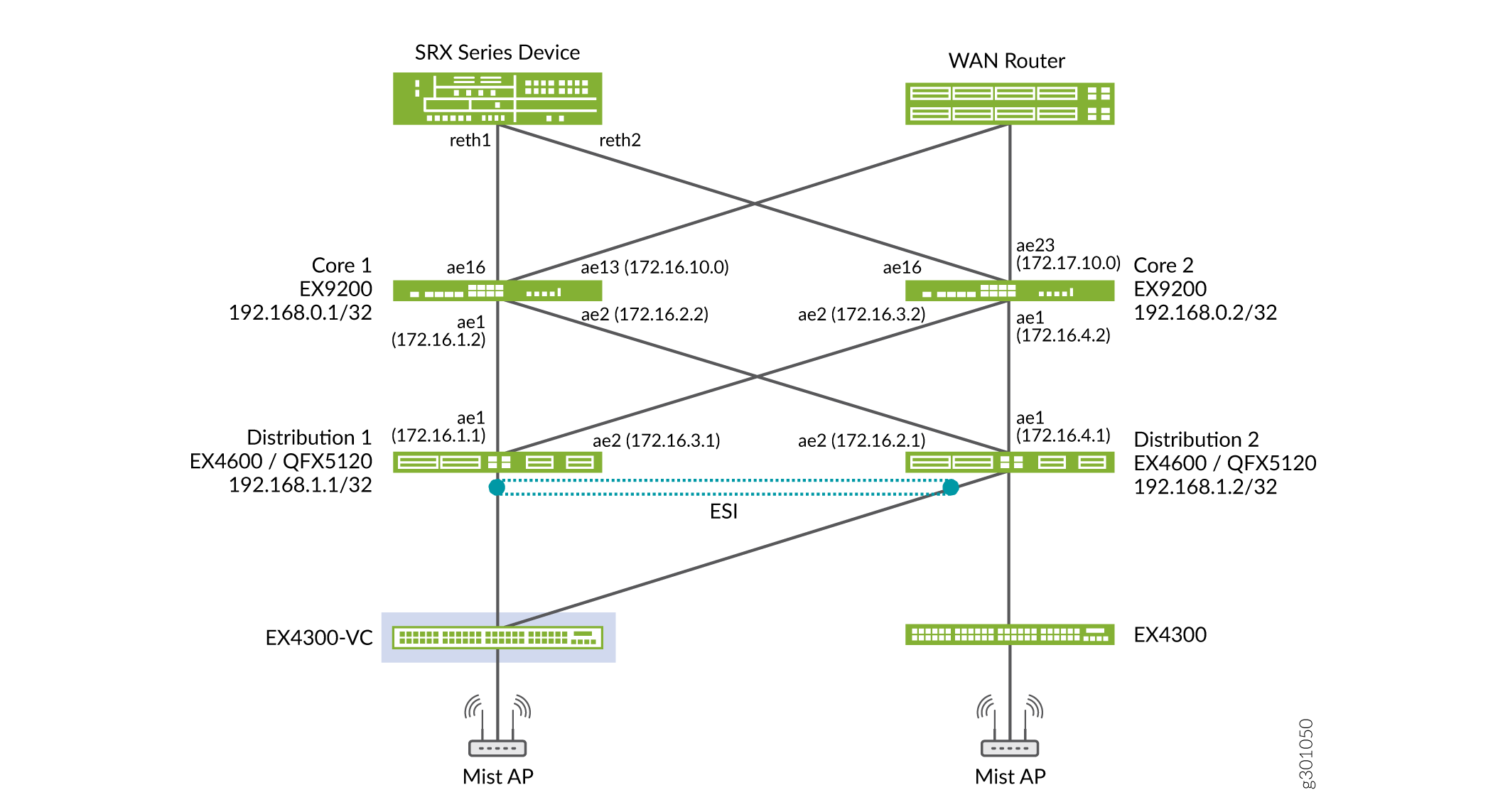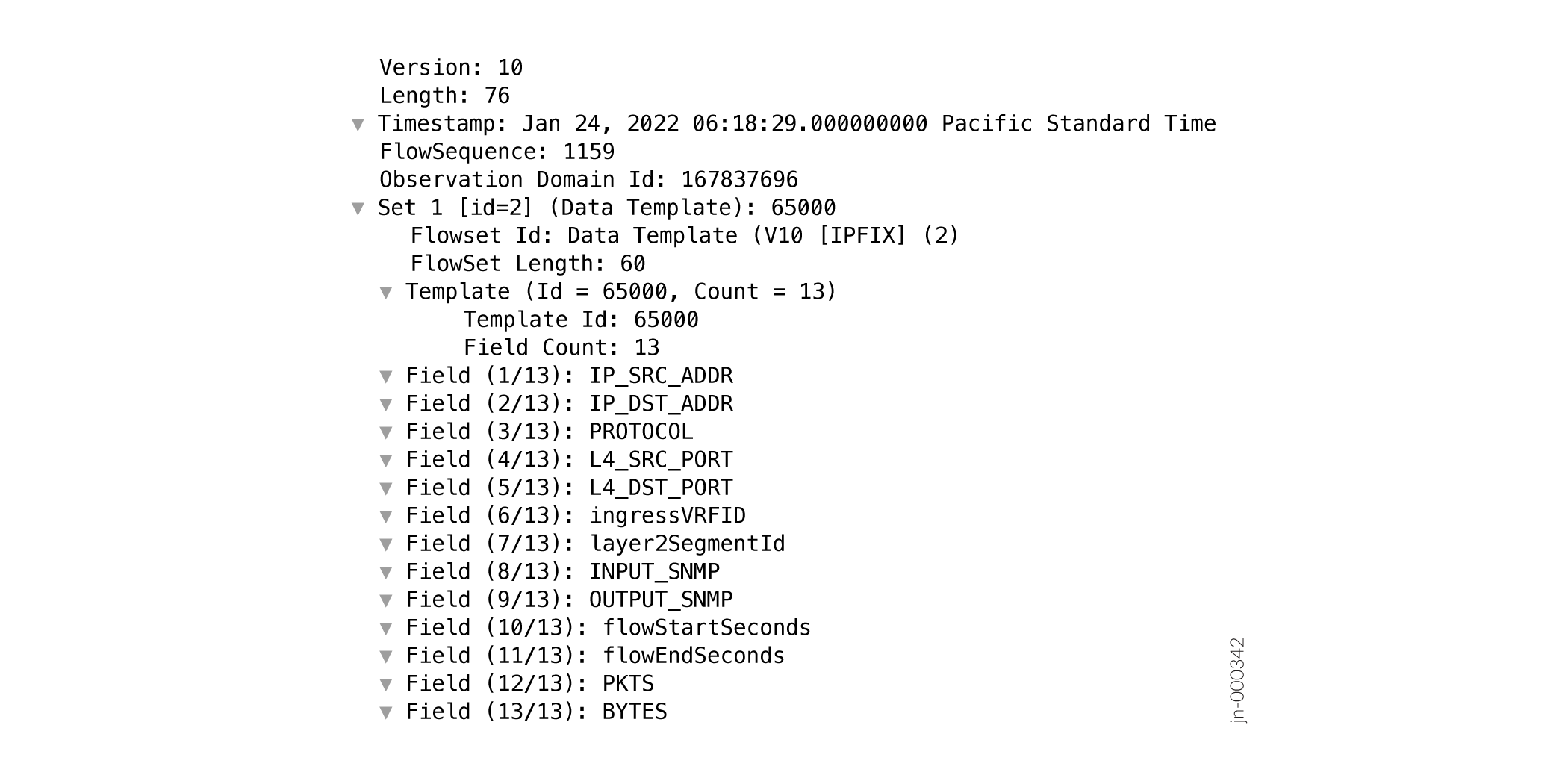- play_arrow Flow Monitoring and Flow Collection Services
- play_arrow Understanding Flow Monitoring
- play_arrow Monitoring Traffic Using Active Flow Monitoring
- Configuring Active Flow Monitoring
- Active Flow Monitoring System Requirements
- Active Flow Monitoring Applications
- Active Flow Monitoring PIC Specifications
- Active Flow Monitoring Overview
- Active Flow Monitoring Overview
- Example: Configuring Active Monitoring on an M, MX or T Series Router’s Logical System
- Example: Configuring Flow Monitoring on an MX Series Router with MS-MIC and MS-MPC
- Configuring Services Interface Redundancy with Flow Monitoring
- Configuring Inline Active Flow Monitoring Using Routers, Switches or NFX250
- Configuring Flow Offloading on MX Series Routers
- Configuring Active Flow Monitoring on PTX Series Packet Transport Routers
- Configuring Actively Monitored Interfaces on M, MX and T Series Routers
- Collecting Flow Records
- Configuring M, MX and T Series Routers for Discard Accounting with an Accounting Group
- Configuring M, MX and T Series Routers for Discard Accounting with a Sampling Group
- Configuring M, MX and T Series Routers for Discard Accounting with a Template
- Defining a Firewall Filter on M, MX and T Series Routers to Select Traffic for Active Flow Monitoring
- Processing IPv4 traffic on an M, MX or T Series Router Using Monitoring services, Adaptive services or Multiservices Interfaces
- Replicating M, MX and T Series Routing Engine-Based Sampling to Multiple Flow Servers
- Replicating Version 9 Flow Aggregation From M, MX and T Series Routers to Multiple Flow Servers
- Configuring Routing Engine-Based Sampling on M, MX and T Series Routers for Export to Multiple Flow Servers
- Example: Copying Traffic to a PIC While an M, MX or T Series Router Forwards the Packet to the Original Destination
- Configuring an Aggregate Export Timer on M, MX and T Series Routers for Version 8 Records
- Example: Sampling Configuration for M, MX and T Series Routers
- Associating Sampling Instances for Active Flow Monitoring with a Specific FPC, MPC, or DPC
- Example: Sampling Instance Configuration
- Example: Sampling and Discard Accounting Configuration on M, MX and T Series Routers
- play_arrow Monitoring Traffic Using Passive Flow Monitoring
- Passive Flow Monitoring Overview
- Passive Flow Monitoring System Requirements for T Series, M Series and MX Series Routers
- Passive Flow Monitoring Router and Software Considerations for T Series, M Series and MX Series Routers
- Understanding Passive Flow Monitoring on T Series, M Series and MX Series Routers
- Enabling Passive Flow Monitoring on M Series, MX Series or T Series Routers
- Configuring Passive Flow Monitoring
- Example: Passive Flow Monitoring Configuration on M, MX and T Series Routers
- Configuring a Routing Table Group on an M, MX or T Series Router to Add Interface Routes into the Forwarding Instance
- Using IPSec and an ES PIC on an M, MX or T Series Router to Send Encrypted Traffic to a Packet Analyzer
- Applying a Firewall Filter Output Interface on an M, MX or T Series Router to Port-mirror Traffic to PICs or Flow Collection Services
- Monitoring Traffic on a Router with a VRF Instance and a Monitoring Group
- Specifying a Firewall Filter on an M, MX or T Series Router to Select Traffic to Monitor
- Configuring Input Interfaces, Monitoring Services Interfaces and Export Interfaces on M, MX or T Series Routers
- Establishing a VRF Instance on an M, MX or T Series Router for Monitored Traffic
- Configuring a Monitoring Group on an M, MX or T Series Router to Send Traffic to the Flow Server
- Configuring Policy Options on M, MX or T Series Routers
- Stripping MPLS Labels on ATM, Ethernet-Based and SONET/SDH Router Interfaces
- Using an M, MX or T Series Router Flow Collector Interface to Process and Export Multiple Flow Records
- Example: Configuring a Flow Collector Interface on an M, MX or T Series Router
- play_arrow Processing and Exporting Multiple Records Using Flow Collection
- play_arrow Logging Flow Monitoring Records with Version 9 and IPFIX Templates for NAT Events
- Understanding NAT Event Logging in Flow Monitoring Format on an MX Series Router or NFX250
- Configure Active Flow Monitoring Logs for NAT44/NAT64
- Configuring Log Generation of NAT Events in Flow Monitoring Record Format on an MX Series Router or NFX250
- Exporting Syslog Messages to an External Host Without Flow Monitoring Formats Using an MX Series Router or NFX250
- Exporting Version 9 Flow Data Records to a Log Collector Overview Using an MX Series Router or NFX250
- Understanding Exporting IPFIX Flow Data Records to a Log Collector Using an MX Series Router or NFX250
- Mapping Between Field Values for Version 9 Flow Templates and Logs Exported From an MX-Series Router or NFX250
- Mapping Between Field Values for IPFIX Flow Templates and Logs Exported From an MX Series Router or NFX250
- Monitoring NAT Events on MX Series Routers by Logging NAT Operations in Flow Template Formats
- Example: Configuring Logs in Flow Monitoring Format for NAT Events on MX Series Routers for Troubleshooting
-
- play_arrow Flow Capture Services
- play_arrow Dynamically Capturing Packet Flows Using Junos Capture Vision
- play_arrow Detecting Threats and Intercepting Flows Using Junos Flow-Tap and FlowTapLite Services
- Understanding the FlowTap and FlowTapLite Services
- Understanding FlowTap and FlowTapLite Architecture
- Configuring the FlowTap Service on MX Series Routers
- Configuring a FlowTap Interface on MX Series Routers
- Configuring FlowTap and FlowTapLite Security Properties
- FlowTap and FlowTapLite Application Restrictions
- Examples: Configuring the FlowTapLite Application on MX Series and ACX Series Routers
- Configuring FlowTapLite on MX Series Routers and M320 Routers with FPCs
-
- play_arrow Sampling and Discard Accounting Services
- play_arrow Sampling Data Using Traffic Sampling and Discard Accounting
- play_arrow Sampling Data Using Inline Sampling
- Understand Inline Active Flow Monitoring
- Configuring Inline Active Flow Monitoring Using Routers, Switches or NFX250
- Configuring Inline Active Flow Monitoring on MX80 and MX104 Routers
- Configuring Inline Active Flow Monitoring on PTX Series Routers
- Inline Active Flow Monitoring of MPLS-over-UDP Flows on PTX Series Routers
- Inline Active Flow Monitoring on IRB Interfaces
- Example: Configuring Inline Active Flow Monitoring on MX Series and T4000 Routers
- play_arrow Sampling Data Using Flow Aggregation
- Understanding Flow Aggregation
- Enabling Flow Aggregation
- Configuring Flow Aggregation on MX, M and T Series Routers and NFX250 to Use Version 5 or Version 8 cflowd
- Configuring Flow Aggregation on MX, M, vMX and T Series Routers and NFX250 to Use Version 9 Flow Templates
- Configuring Flow Aggregation on PTX Series Routers to Use Version 9 Flow Templates
- Configuring Inline Active Flow Monitoring to Use IPFIX Flow Templates on MX, vMX and T Series Routers, EX Series Switches, NFX Series Devices, and SRX Series Firewalls
- Configuring Flow Aggregation to Use IPFIX Flow Templates on PTX Series Routers
- Configuring Observation Domain ID and Source ID for Version 9 and IPFIX Flows
- Configuring Template ID and Options Template ID for Version 9 and IPFIX Flows
- Including Fragmentation Identifier and IPv6 Extension Header Elements in IPFIX Templates on MX Series Routers
- Directing Replicated Flows from M and T Series Routers to Multiple Flow Servers
- Logging cflowd Flows on M and T Series Routers Before Export
- Configuring Next-Hop Address Learning on MX Series and PTX Series Routers for Destinations Accessible Over Multiple Paths
-
- play_arrow Real-Time Performance Monitoring and Video Monitoring Services
- play_arrow Monitoring Traffic Using Real-Time Performance Monitoring and Two-Way Active Monitoring Protocol (TWAMP)
- Understanding Using Probes for Real-Time Performance Monitoring on M, T, ACX, MX, and PTX Series Routers, EX and QFX Switches
- Configuring RPM Probes on M, MX and T Series Routers and EX Series Switches
- Understanding Real-Time Performance Monitoring on EX and QFX Switches
- Real-Time Performance Monitoring for SRX Devices
- Configuring RPM Receiver Servers
- Limiting the Number of Concurrent RPM Probes on M, MX, T and PTX Routers and EX Series Switches
- Configuring RPM Timestamping on MX, M, T, and PTX Series Routers and EX Series Switches
- Configuring the Interface for RPM Timestamping for Client/Server on a Switch (EX Series)
- Analyzing Network Efficiency in IPv6 Networks on MX Series Routers Using RPM Probes
- Configuring BGP Neighbor Discovery Through RPM
- Examples: Configuring BGP Neighbor Discovery on SRX Series Firewalls and MX, M, T and PTX Series Routers With RPM
- Trace RPM Operations
- Examples: Configuring Real-Time Performance Monitoring on MX, M, T and PTX Series Routers
- Enabling RPM on MX, M and T Series Routers and SRX Firewalls for the Services SDK
- Understand Two-Way Active Measurement Protocol
- Configure TWAMP on ACX, MX, M, T, and PTX Series Routers, EX Series and QFX10000 Series Switches
- Example: Configuring TWAMP Client and Server on MX Series Routers
- Example: Configuring TWAMP Client and Server for SRX Series Firewalls
- Understanding TWAMP Auto-Restart
- Configuring TWAMP Client and TWAMP Server to Reconnect Automatically After TWAMP Server Unavailability
- play_arrow Managing License Server for Throughput Data Export
- play_arrow Testing the Performance of Network Devices Using RFC 2544-Based Benchmarking
- Understanding RFC 2544-Based Benchmarking Tests on MX Series Routers and SRX Series Firewalls
- Understanding RFC2544-Based Benchmarking Tests for E-LAN and E-Line Services on MX Series Routers
- Supported RFC 2544-Based Benchmarking Statements on MX Series Routers
- Configuring an RFC 2544-Based Benchmarking Test
- Enabling Support for RFC 2544-Based Benchmarking Tests on MX Series Routers
- Example: Configure an RFC 2544-Based Benchmarking Test on an MX104 Router for Layer 3 IPv4 Services
- Example: Configuring an RFC 2544-Based Benchmarking Test on an MX104 Router for UNI Direction of Ethernet Pseudowires
- Example: Configuring an RFC 2544-Based Benchmarking Test on an MX104 Router for NNI Direction of Ethernet Pseudowires
- Example: Configuring RFC2544-Based Benchmarking Tests on an MX104 Router for Layer 2 E-LAN Services in Bridge Domains
- Example: Configuring Benchmarking Tests to Measure SLA Parameters for E-LAN Services on an MX104 Router Using VPLS
- play_arrow Configuring RFC 2544-Based Benchmarking Tests on ACX Series
- RFC 2544-Based Benchmarking Tests for ACX Routers Overview
- Layer 2 and Layer 3 RFC 2544-Based Benchmarking Test Overview
- Configuring RFC 2544-Based Benchmarking Tests
- Configuring Ethernet Loopback for RFC 2544-Based Benchmarking Tests
- RFC 2544-Based Benchmarking Test States
- Example: Configure an RFC 2544-Based Benchmarking Test for Layer 3 IPv4 Services
- Example: Configuring an RFC 2544-Based Benchmarking Test for NNI Direction of Ethernet Pseudowires
- Example: Configuring an RFC 2544-Based Benchmarking Test for UNI Direction of Ethernet Pseudowires
- Configuring a Service Package to be Used in Conjunction with PTP
- play_arrow Tracking Streaming Media Traffic Using Inline Video Monitoring
- Understanding Inline Video Monitoring on MX Series Routers
- Configuring Inline Video Monitoring on MX Series Routers
- Inline Video Monitoring Syslog Messages on MX Series Routers
- Generation of SNMP Traps and Alarms for Inline Video Monitoring on MX Series Routers
- SNMP Traps for Inline Video Monitoring Statistics on MX Series Routers
- Processing SNMP GET Requests for MDI Metrics on MX Series Routers
-
- play_arrow Configuration Statements and Operational Commands
Flow-Based Telemetry for VXLANs (QFX5120)
Flow based telemetry (FBT) for VXLANs in Junos OS enables per-flow-level analytics on IRB interfaces, using inline monitoring services to create flows, collect them, and export them to a collector using the open standard IP Flow Information Export (IPFIX) template to organize the flow.
FBT for VXLANs Overview
You can configure flow-based telemetry (FBT) for VXLANs for the QFX5120 -32C and QFX5120-48y-8c switches. FBT for VXLANs enables inline telemetry data for VXLANs that have either centrally-routed bridging (CRB) or edge-routed bridging (ERB) overlays. FBT for VXLANs enables per-flow-level analytics for IRB interfaces, using inline monitoring services to create flows, collect them, and export them to a collector. With inline monitoring services, you can monitor every IPv4 and IPv6 packet on both ingress and egress directions of an interface.
Benefit of FBT for VXLANs
With FBT for VXLANs, you can enable inline telemetry data for EVPN-VXLAN architectures that have either CRB or ERB overlays, giving you an additional source of information about your network,
A VXLAN with a CRB overlay has core switches configured as Layer/Layer 3 VXLAN gateways where the Integrated Routing and Bridging (IRB) interfaces for the virtual networks are configured on the core switches. In contrast, core switches in a VXLAN with an ERB overlay provide transport of EVPN type-2 and type-5 routes and the IRB interfaces are configured on the distribution switches. The ERB design also enables faster server-to-server, intra-campus traffic. As a result, with an ERB overlay, routing happens much closer to the end systems than with a CRB overlay. Figure 1and Figure 2 show sample topologies for these overlays. To learn more about these EVPN-VXLAN architectures, see Technology Primer: EVPN-VXLAN Fabrics for the Campus.


Flow Export Overview
FBT for VXLANs uses software-based IPFIX flow export. (IPFIX is defined in RFC
7011.) A flow is a sequence of packets that have the same core set of parameters
on an interface, some of which are source IP, destination IP, source port,
destination port, and protocol. This core set of parameters is called a flow
key, and the software uses this key to learn about the flows. For each flow, the
software collects various parameters and exports the actual packet up to the
configured clip length to a collector using the open standard IPFIX template to
organize the flow. Once there is no active traffic for a flow, the flow is aged
out after the configured inactive-timeout period (configure the
flow-inactive-timeout statement at the [edit
services inline-monitoring template
template-name] hierarchy level).
For FBT for VXLANs, the flow key differs depending on whether you are monitoring IPv4 or IPv6 traffic. The flow key for IPv4 traffic is explained in Table 1 and the flow key for IPv6 traffic is explained in Table 2. For both IPv4 and IPv6 traffic, in addition to the key fields, the flow contains fields for the ingress and egress ports, the flow start and end time, and the byte and packet count delta. The flow start time is the timestamp for when the software learned the flow. The flow stop time is the timestamp of the latest counter query. A sample IPFIX data template for IPv4 traffic is shown in Figure 3.
| Field | Field size in bytes |
|---|---|
Source IP address | 4 |
Destination IP address | 4 |
Protocol (TCP or UDP) | 1 |
Source port (TCP or UDP) | 2 |
Destination port (TCP or UDP) | 2 |
Virtual routing and forwarding table (VRF) identifier | 2 |
Ingress port | 1 |
VXLAN network identifier (layer 2 segment ID) | 3 |
| Field | Field size in bytes |
|---|---|
Source IP address | 4 |
Destination IP address | 4 |
Protocol (TCP or UDP) | 1 |
Source port (TCP or UDP) | 2 |
Destination port (TCP or UDP) | 2 |
Virtual routing and forwarding table (VRF) identifier | 2 |

Limitations and Caveats
FBT for VXLANs is supported only on Junos OS.
Only IRB interfaces are supported. For EVPN-VXLAN networks with CRB overlays, you can only monitor the IRB interfaces on the spine. For EVPN-VXLAN networks with ERB overlays, you can only monitor the IRB interfaces on the leaves.
Only one inline-monitoring instance and one collector are supported.
The collector must be reachable through a network interface, not only through a management or loopback interface.
You cannot configure an option template identifier or a forwarding class.
The IPFIX Option Data Record and IPFIX Option Data Template are not supported.
Flow learning and tracking is based on client traffic data only, not the outer tunnel header. Flow learning is software-based and takes up to 10 seconds per flow.
Counters are not active until the software learns the flow and installs the flow in the flow table.
The software does not use the TCP FIN/RST flag for flow aging.
The software requires a layer 3 header in the packet, and supports only the TCP and UDP protocols.
The reported egress port might not be correct with LAG, ECMP, broadcast, multicast, or unknown traffic, if the egress port is in a different VRF.
Configure FBT for VXLANs (QFX5120)
You can configure flow-based telemetry (FBT) for VXLANs for the QFX5120 -32C and QFX5120-48y-8c switches. FBT for VXLANs enables inline telemetry data for VXLANs that have either centrally-routed bridging (CRB) or edge-routed bridging (ERB) overlays. FBT for VXLANs enables per-flow-level analytics for IRB interfaces, using inline monitoring services to create flows, collect them, and export them to a collector. With inline monitoring services, you can monitor every IPv4 and IPv6 packet on both ingress and egress directions of an interface.
Before you can configure FBT for VXLANs, you must first enable software-based IPFIX flow export and must allocate exact-match memory in the unified forwarding table to learn the flows. To configure:
user@host# set system packet-forwarding-options ipfix-sw-mode user@host# set chassis forwarding-options em-hw-profile user@host# commit
After you commit the configuration, the system then prompts you to reboot the system.
To configure FBT for VXLANs:
Change History Table
Feature support is determined by the platform and release you are using. Use Feature Explorer to determine if a feature is supported on your platform.





















